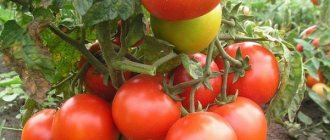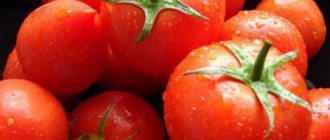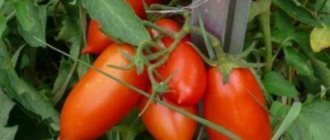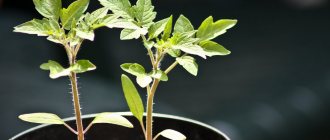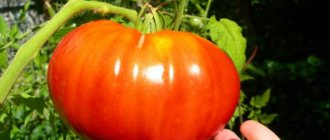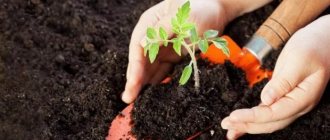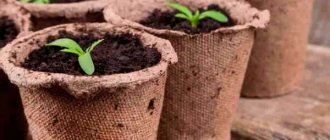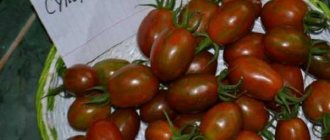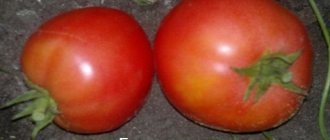There are many good varieties, and sometimes dozens of varieties of tomatoes grow in farmers’ beds. But it’s impossible not to try Marusya. The young variety appeared in 2007, but has already become a favorite for many. Massive bunches hung with neat tomatoes, endurance and stress resistance are just part of the advantages.
| Height | Landing location | Ripening time | Fruit color | Fruit size | Origin | Fruit shape |
| Medium height | Greenhouse, Open ground | Mid-early | Reds | Average | Variety | Plum-shaped or oval |
Description and characteristics of tomato Marusya
The plant is annual. It belongs to a mid-season determinate variety that stops growing after the formation of an ovary with a fruit at the end of the shoot. Designed for planting in open ground and in greenhouse conditions. Tolerates summer heat and low night temperatures well.
Does not require special care.
Appearance
It grows maximum up to 1 m in greenhouse conditions and up to 55-85 cm in open ground.
The bush is covered with green leaves and fruits collected in clusters like grapes. During fruiting, it requires obligatory attachment to a support.
The stem is dense, consists of 1-2 trunks. It contains cuttings with medium-large leaves of rich green color. The leaf structure is odd-pinnate. It is fleshy, divided into small lobes and covered with small hairs.
The cuttings with leaves are arranged in a convenient way. They cover the fruits from bright sunlight and prevent the occurrence of burns, but transmit enough light for the normal formation of tomatoes.
A fruit cluster is formed through each leaf, starting from the sixth. There are 4-8 small yellow flowers on it, which consist of a simple inflorescence.
Description of fruits
The tomato is medium-fruited, weighs 60-80 g. The shape is plum-shaped, slightly elongated. The size of all fruits is almost the same.
The tomato is covered with a thin, durable skin that is not prone to cracking. The surface is smooth. The color is bright red.
Inside, the fruit is divided into 2-3 chambers. The structure of the pulp is dense and fleshy. The taste is rich. Dry matter is contained in large quantities.
The Marusya tomato fruit holds firmly on the bush and does not fall off.
Productivity and fruiting
Harvesting can be done 105-110 days after planting. The deadline may be delayed by a week. It depends on the climate in the region and growing conditions.
From the beginning of fruit set to maturity, 1-1.5 months pass. The harvest period occurs at the end of July - beginning of August, depending on the length of the summer period.
Up to 2 kg of tomatoes are harvested from one bush, and from 1 sq. m up to 6.9-7.5 kg. This is a good indicator for a medium-fruited variety.
Harvesting can be increased if you apply pinching at the right time or grow in favorable and stable greenhouse conditions.
Area of application of fruits
The Marusya tomato is grown for personal use and for sale. The fruits are stored for a long time, while retaining their freshness, beneficial properties and taste.
They are eaten in their natural form and used in cooking for preparing dishes. Juices and ketchup are made from them. Tomatoes do not lose their taste when canned.
Resistance to diseases and pests
Please note the following features:
- The variety is immune to Fusarium wilt and verticillium wilt.
- When a plant is infected with whitefly, it is treated with the special preparation Confidor.
- If slugs are found on the fruits, reconsider the frequency of watering. Dig up and treat the soil around with a mixture of ash, tobacco dust and lime.
- Spider mites are removed by spraying the bushes with Karbofos.
Characteristics of the variety
The Marusya tomato was bred by Russian breeders relatively recently. The year of release is considered to be 2007.
The Marusya tomato was created specifically for cultivation in all regions of the country. In cold climates, planting is carried out in greenhouses or under film, and in regions with a temperate climate it is possible to grow in open areas.
Description of the plant
The Marusya tomato variety ripens in an average amount of time. The growing season is believed to be about 100 days. The bush is of a determinate type, grows up to 100 cm. The Marusya tomato tends to produce grape-shaped fruits.
According to the description, the leaves of the bush are medium in size, rich dark green in color. It is not necessary to form a bush into 1 stem: it copes with this task perfectly.
The tomato variety is also highly resistant to various diseases.
Description of the fruit
According to the description, the fruits are small. On average, the weight of one ripe fruit is about 150-180 g. The shape of the fruit is oval, a little like a plum. The color of the fruit is rich red, without stripes or blemishes.
The pulp is juicy and not watery, even though the amount of dry matter in the pulp is minimal. The taste is sweet, with a slight sourness. The yield is high: about 7 kg of tomatoes are harvested from one bush. Tomatoes of the Marusya variety are a universal species.
Growing from seeds
Planting a crop begins with preparing and germinating seeds. This variety is not a hybrid, so seeds can be prepared from fruits from the previous harvest. Or buy it in a specialized store.
You need to start germinating seeds 60-65 days before planting them in a permanent place in open ground or a greenhouse. In mid or late March, depending on the length of the summer season.
Seed preparation
Includes their processing. First you need to select the most viable seeds that will give a good harvest. The selection process takes place in a specially prepared liquid.
Add a pinch of salt to a glass of water, place the seeds and mix thoroughly. Leave for a few minutes. As a result, all empty seeds should float.
Next, they are disinfected. For a quick procedure, prepare a weak solution of manganese. Place the seeds there for 20-30 minutes.
In order to improve germination, create lasting immunity in a young seedling, and increase productivity in an adult plant, prepare the following solution:
- dissolve baking soda;
- add 4 drops of Fitosporin and aloe plant juice;
- Place the seeds in this mixture overnight.
The solution also provides disinfection.
Purchased seeds do not require processing.
Seeds must be hardened. They are wrapped in damp gauze and placed in the refrigerator for a day.
Sowing seeds
For planting you will need a small container in the form of a wooden box or peat cup.
The composition of the soil should be light and contain organic matter. The land is purchased ready-made or made independently. Preparation begins 2 weeks before use.
To prepare the soil you will need:
- 2 parts of turf land;
- 1 part each: sand, ash, rotted manure and peat.
After this, the soil is disinfected by calcination in the oven and impregnation with a manganese solution. The soil is dried and placed in cellophane. Place in a dark place to restore beneficial microflora.
Sequential steps for planting seeds:
- Fill the container 2/3 with soil;
- put 2-3 seeds in one place;
- maintain a distance of 3 cm between seeds;
- Sprinkle a layer of earth on top;
- moisten the soil with a spray bottle;
- cover with plastic wrap.
Place the containers in a dark place. The ambient temperature should be around +25 C.
Read more about germinating tomato seeds for seedlings here.
Seedling care
After 4-7 days, shoots appear. The container with greens is transferred to a cooler place for hardening. The temperature should not fall below 16 C. A balcony, veranda or other similar room is suitable for this.
The film must be removed gradually to give the seedlings time to get used to the new temperature. Start with 2-3 hours during the day and gradually increase it.
The ambient temperature should not be high. Otherwise, the seedlings will begin to grow actively. This will lead to poor adaptation and survival of the plant after transplantation.
Seedling care includes:
- Lighting. Good growth is ensured by constant natural light for at least 16 hours a day. If there is a deficiency in it, you need to extend daylight hours with the help of artificial lamps.
- Watering. Irrigate the soil under young seedlings with a spray bottle.
- Feeding. 2 weeks after emergence, apply the first fertilizing. To do this, use weakly diluted natural organic matter in the form of manure or bird droppings.
When caring for tender seedlings, try to keep moisture away from the leaves.
Transplanting seedlings
The next step in caring for seedlings is picking. The process of transplanting young shoots into a large container of 200-500 ml. It is carried out on days 8-14, when the plant has two leaves.
This procedure can be neglected if the seeds were initially planted in separate large cups. Then they have enough space for full growth and there is no contact with the leaves of a neighboring shoot.
The sprout is transplanted into soil with the same composition as for germinating seeds. The seedlings need to be taken along with a lump of earth around the roots. You can use a small spoon for scooping.
Be sure to harden it. This is done 2-3 weeks before transplanting into open ground. You need to take the sprouts out into fresh air every day. Start with 5-10 minutes and gradually increase the time.
Gradually, the seedlings should harden enough to be outdoors for the last few nights and not freeze.
Growing in open ground
Seedlings about 1.5 months old are planted in open space at the end of April or beginning of May. The exact time depends on the region and temperature conditions. Proper compliance with planting conditions and rules guarantees a good future harvest.
Outdoor growing conditions
The weather should stabilize, and the temperature at night should not fall below 15-16 C. Even short-term frosts can destroy young shoots.
The surface layer of soil up to 25 cm deep should warm up to 16-18 C.
Tomatoes should be planted when there is almost no sun. Better in the morning or evening. It is advisable that in the following days the sun should not shine brightly or not exist at all.
You can learn more about growing tomatoes in open ground from this article.
Soil and fertilizers
A tomato grows better if carrots, legumes, zucchini or cruciferous vegetables grew in the same place before it. The soil needs to be prepared in advance and fertilized in the fall.
In the spring, dig up the bed to a depth of 15 cm and add organic fertilizer in the form of vegetable compost or mature humus 1-2 weeks before planting. Mineral ones are also suitable for additional saturation of the soil. The applied fertilizers are mixed well with the soil. Afterwards, be sure to water everything.
Manure should not be used; it can burn through the fragile root system.
The day before planting, water to completely saturate the soil with moisture.
Selection of seedlings
It's worth making a selection. The young plant must be healthy. Have many juicy, rich green leaves on a thick and strong stem and a fully developed root. Seedlings should have the first flower cluster before the bud opens.
If the weather has not yet settled and a peduncle appears on the seedlings, you need to carefully pinch it off.
Landing
Tomato is planted in rows. The distance between them is 65-75 cm. The row consists of holes located 40-60 cm from each other. The depth of the hole is 15-20 cm and the width is 10-15 cm.
Step by step process:
- Place the seedlings together with a lump of earth into the prepared hole 1-2 cm deeper than its growth level in the container.
- Sprinkle with soil and water generously with warm, settled water.
- For each hole, prepare in advance a strong support, in the form of a wooden stake, to tie the plant down as it grows. Place it at a distance of 7-9 cm from the future bush.
When planting a plant in a hole, you can shorten the main root slightly. There will be stimulation for the growth of lateral roots. In the future, the tomato trunk will be stronger.
Planting seedlings in a permanent place
It is recommended to transplant seedlings in April - May, depending on the outside air temperature. In this case, the soil should be warmed up to +16°C, and there should be no night frosts. The appearance of a flower cluster on the plant indicates that the plant is ready to be planted in the ground.
Please note that the planting process should be completed before it turns into a bud and begins to open. If the brush appeared too early, and it is still cold outside, then it is recommended to remove it. A slightly cloudy day is the best weather for planting, which will help the plant adapt.
As for the planting scheme, it is necessary to maintain a distance of 30–50 cm between plants planted in groups of 6–9. In this case, the interval between the rows should be 50–70 cm. There should be 6–8 bushes per 1 m². For planting, dig a hole 15 cm deep with a diameter of 10–15 cm.
Did you know? Tomatoes were first described in Italy in 1555. People of that time called it “pomodoro”, which translated into Russian means “golden apple”.
Next, you need to cover its bottom with humus and water it. When the liquid is absorbed, plant 1 branch of seedlings in each hole. In this case, the plant is placed in a hole at an angle of less than 90° and sprinkled with soil - its composition should include sand, rotted manure and ash.
Features of care
This tomato variety does not require special care. All actions should be aimed at the formation of the bush, timely watering and soil care.
Watering
Basic rules of watering:
- Irrigation of the soil should be regular. Do not let it dry out or create stagnation.
- Use only warm and settled water.
- Water in the morning or evening.
- Direct the stream of water only at the root. Under no circumstances should it fall on the leaves.
The need for watering can be easily determined by the drying out of the top layer of soil. Lack of moisture during fruit ripening can lead to reduction in size and cracking.
Loosening the soil and weeding
After each irrigation of the soil, it must be loosened to restore air penetration. And at the same time pull out weeds that take nutrients from the soil from the tomato and cause diseases.
To better retain moisture, especially in summer, you can mulch with straw or sawdust.
Stepson and garter
Stepping is the timely removal of lateral shoots to increase yield. For Tomato Marusya, you should remove only those branches that are located below the first flower cluster.
It is also helpful to cut off the leaves on the lower trunk of the bush to allow air circulation.
A garter is needed to help the plant during fruiting. As soon as the ovary with a bunch of first fruits begins to appear on the bush, it is worth doing the first garter.
The tree trunk is carefully secured to the support in 2-3 places. As plants grow and develop, they change tie levels.
Top dressing
During growth, a tomato actively absorbs useful components from the soil and quickly depletes it. Also, the formation and ripening of fruits occurs in a short time and it is at this time that the plant especially needs additional nutrition.
Two weeks after planting the tomato in open ground, you need to carry out the first fertilizing. Bird droppings or mullein work well.
Carry out the second feeding after 10-14 days. Feed with ready-made mineral fertilizers or prepare the mixture yourself.
For 10 liters of water take:
- 60 g superphosphate;
- 1 g boric acid;
- 25 g ammonium nitrate;
- 15 g potassium salt.
The following fertilizing is applied every two weeks. You can use yeast, containing phosphorus or potassium. Just don’t use nitrogen, which leads to active growth of greenery.
Requirements for cultivation and care
According to reviews, the yield of the Marusya tomato depends on how the tomatoes are grown. Among the mandatory requirements:
- selection and disinfection of seed material;
- sowing fifty-five days before transplanting into open ground;
- keeping seedlings in rooms with an air temperature of 25 degrees, sufficient lighting;
- picking seedlings after the appearance of two true leaves into separate pots;
- fertilizing with specialized fertilizers;
- planting seedlings in a greenhouse or in garden beds.
If you plant seedlings in open ground, then this should be done in the evening or in cloudy weather. Tender bushes are afraid of the scorching rays of the sun.
To ensure that tomatoes develop successfully and do not get sick, they are sprayed with Fitosporin. Treatment of vegetable plants with a mixture of whey and a few drops of iodine will also be a preventive measure. Solutions of wood ash, tobacco dust, and lime will save you from slugs.
Properly organized watering is important for tomatoes of the Marusya variety. It is necessary to moisten the soil regularly, making sure that the top layer of soil dries out. Excess moisture is also dangerous for tomatoes. The fruits may crack if the watering regime is disturbed - after a shortage of water, there is an abundance of it. And the flowers fall off if the plant grows vigorously and produces a lot of extra shoots. In such cases, the side shoots are broken out.
Tomato bushes are fed for the first time with mullein or bird droppings. Organic substances are diluted in a bucket of water in accordance with the proportions. The next time, after ten days, mineral fertilizers are added to the soil: twenty-five grams of ammonium nitrate per ten liters of water, sixty grams of superphosphate, fifteen grams of potassium salt. It is necessary to dilute one gram of boric acid in the solution. Two weeks later, one liter of nutrient mixtures is again added to each well. An excess of nitrogenous fertilizers can cause the ovaries to fall off. You need to think about this when organizing fertilizing.
Tomatoes ripen faster and become sweet if the shadow of leaves does not fall on them. Unripe tomatoes are collected and brought to ripeness in a dark room where the temperature reaches 26 degrees Celsius.
Prevention of diseases and pests
It is advisable, for preventive purposes, to inspect the mulch for the appearance of slugs in it. Also periodically spray the bush. To do this, use a soap solution. But it cannot be used if the plant is less than one and a half months from the moment it was planted. If necessary, the frequency of spraying is every 2-3 weeks. Prophylaxis is completed 1 month before harvest.
Spraying with whey with the addition of 1-2 drops of iodine will help against fungal diseases.
Or use the ready-made product Fitosporin. It will protect the plant from bacterial diseases.
Pest Control
Despite its high resistance to the most common diseases, the Marusya tomato requires preventive spraying, as well as treatments against pests:
- Phytosporin with whey and a few drops of iodine or wood ash protects against late blight;
- Infusions of wood ash, tobacco dust or lime solution are effective against slugs;
- Periodic spraying with a soap solution is also useful;
- Karbofos is used against spider mites.
Harvest and storage
The fruit is removed from the bush as soon as it is ripe. The degree of maturity is determined by its rich, bright red color.
When there is an early cold spell, be sure to collect all the tomatoes, otherwise they will disappear. If some fruits are not ripe, they need to be placed in a warm, lighted place.
Ripe fruits are stored for no more than 2 weeks. Unripe up to 3 weeks.
Rules for storing tomatoes:
- Do not use a refrigerator (low temperatures reduce the aroma).
- Remove all dry leaves from the fruit.
- Place in a single layer on a wooden or plastic tray.
- Place dry sawdust under and between the fruits.
- Use a dry and dark room.
To speed up the ripening of some harvested tomatoes, it is worth placing them next to ripened ones.
Description of fruits
The dense, juicy fruits of the Marusya variety are oval in shape and acquire a bright red color at the stage of full ripening. The average weight of ripe tomatoes reaches 80 g. Due to their small size, they are convenient for canning. Despite the not very dense skin, Marusya tomatoes do not crack and tolerate long-term storage and long-term transportation. Already ripe fruits do not fall off, but remain firmly on the branches. Excellent taste makes them universal in purpose:
- tomatoes of the Marusya variety are consumed fresh and in salads;
- used in conservation;
- popular in the form of fresh juices;
- used in the preparation of sauces and vegetable stews.
Reviews from gardeners about the Marusya variety
★★★★★
Natalia, 57 years old, pensioner, Ryazan. This is the first time I planted this variety.
I was afraid that I wouldn’t be able to germinate the seeds myself. But she followed the recommendation and ultimately reaped a good harvest at the end of summer. I am very pleased with the taste. I preserved it for the winter. ★★★★★
Margarita, 64 years old, Smolensk. I'm growing this for the fourth year in a row.
I use a greenhouse. It is easy to care for, the main thing is to water it on time. Tomatoes delight with taste. I treat all neighbors and relatives. Very pleased with the variety. ★★★★★
Valentin, 46 years old, entrepreneur, Kursk. I have a dacha for relaxation.
I have been growing this variety for two years now. As a preventative measure, I periodically spray the bush against pests. But my tomatoes have never been sick with anything. I am reaping good harvests. The fruits are large, dense and with good taste. Hide
Add your review
The Marusya tomato is easy to grow in any climate zone. Suitable for beginner gardeners. Resists diseases well. Gives a stable and high yield. Suitable for long-term storage and transportation. The fruits can be used fresh and for winter preparations.
0
0
Copy link
Reviews
Melnikov Stepan, 72 years old, Kaluga
I have been planting the Marusya tomato for several years now. It is easy to care for - I regularly water and weed the beds. I collect my own seeds from overripe tomatoes, dry them and put them in paper bags, and share them with my neighbors in the spring. Following my example, they also switched to Marusya tomato. The variety is excellent.
Kartashova Galina, 60 years old, Samara
For the first time, having tasted the extraordinary taste of tomatoes, Marusya decided to plant them in her dacha. And I still don’t regret it. Even in dry years, tomato produces good yields. I use only this variety for pickling and recommend it to everyone I know.
Kramarenko Vitaly, 45 years old, Nizhny Novgorod
For two years now I have been growing only the Marusya tomato on my plantations. Due to its delicious taste and excellent presentation, the tomato is in great demand. The fruits do not fall off, so harvest losses are small. Our scientists have developed an excellent variety.
Elizaveta Slonova, 57 years old, Astrakhan
We know and love the Marusya tomato, the photo and description are true. The variety is very popular among our summer residents. Sweet fruits add an extraordinary taste to salads and vegetable dishes. We also use this variety for pickling. Bushes also play a decorative role - they decorate the garden with bright bunches of tomatoes.
